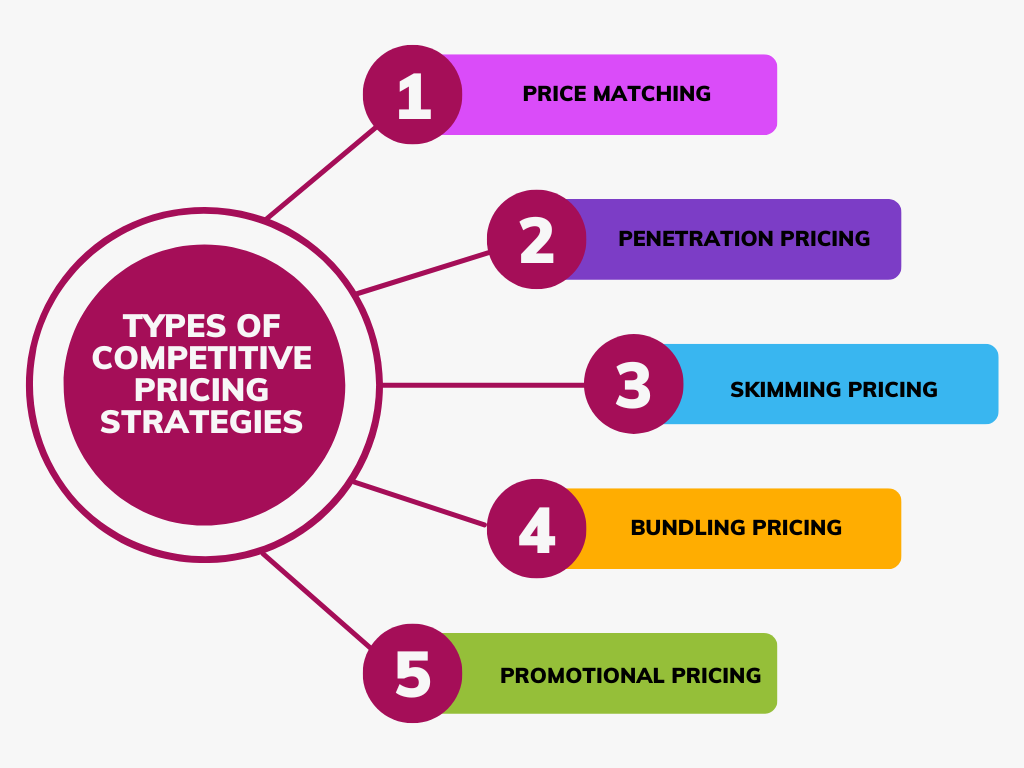What is Competitive Pricing?
Competitive pricing is a strategy used by companies to set their prices based on their competitors’ prices, while maintaining profitability. To implement this strategy, companies need to analyze their competitors’ pricing strategies, products, and target markets.
Competitive pricing can help attract price-sensitive customers and maintain market position, but companies need to be careful not to engage in price wars with competitors. Instead, they should focus on offering additional value through other aspects of their products or services.
Importance of Competitive pricing
- Attract customers: Competitive pricing can help companies attract price-sensitive customers who are looking for the best deal.
- Increase sales: Competitive pricing can lead to increased sales volume as customers may be more willing to purchase products or services at a lower price.
- Gain market share: By offering lower prices than its competitors, a company can gain market share and increase its customer base.
- Stay competitive: In highly competitive markets, businesses need to use competitive pricing to remain competitive and not lose customers to their rivals.
- Build customer loyalty: Competitive pricing can help build customer loyalty as customers may perceive the company as offering good value for money. This can lead to repeat purchases and increased customer lifetime value.
- Respond to market changes: By monitoring their competitors’ prices and adjusting their own prices accordingly, companies can quickly respond to changes in the market and maintain their competitiveness.
- Differentiation: Competing on price alone can make it difficult for a business to differentiate itself from its competitors. However, by offering additional value through other aspects of their products or services, such as quality, features, or customer service, businesses can differentiate themselves from their competitors and gain a competitive advantage
Things to Keep in Mind While Using Competitive Pricing Strategies
- Profit margin: Competitive pricing can result in lower profit margins for companies, which can be unsustainable in the long run.
- Price wars: Companies may engage in price wars with their competitors, which can hurt profitability for all involved.
- Perception of low quality: If a company consistently offers low prices, customers may perceive their products or services as low quality.
- Difficulty in differentiation: Competing solely on price can make it difficult for a company to differentiate itself from its competitors.
- Price sensitivity: Customers may become overly price-sensitive, which can make it difficult for companies to raise their prices in the future.
Types of Competitive Pricing Strategies
Here are some common types of competitive pricing strategies:

Price matching: A company sets its prices to match the prices of its competitors. This strategy is often used by retailers.
Penetration pricing: A company sets its prices lower than its competitors to gain market share. This strategy is often used by companies entering a new market.
Skimming pricing: A company sets its prices higher than its competitors to attract customers who value high-end products or services. This strategy is often used by companies that offer unique or innovative products.
Bundling pricing: A company combines several products or services and offers them at a lower price than if they were purchased separately. This strategy is often used by companies in the technology industry.
Promotional pricing: A company offers discounts, coupons, or other promotions to attract customers. This strategy is often used by retailers and food service companies.
Dynamic pricing: A company adjusts its prices in real-time based on supply and demand, competitor pricing, and other factors. This strategy is often used by e-commerce companies.
It’s important to note that companies may use a combination of these pricing strategies depending on their business goals and the market conditions.
Pricing in eCommerce Industry
Competitive pricing analysis is particularly important in the e-commerce industry due to its highly competitive nature. Here are some steps that businesses in the e-commerce industry can take to conduct a competitive pricing analysis:
- Identify competitors: Identify the main competitors in the market, including both online and offline competitors.
- Use price monitoring tools: Use price monitoring tools, such as E-commerce insights tools like 42Signals, Google Shopping or Amazon’s Best Seller List, to collect data on competitors’ prices.
- Analyze pricing trends: Analyze the data collected to identify any pricing patterns or trends among competitors, such as seasonal pricing fluctuations or frequent sales.
- Track pricing changes: Monitor competitors’ pricing changes in real-time using automated tools, which can help businesses respond quickly to market changes and adjust their pricing strategy accordingly.
- Analyze product positioning: Analyze how the company’s products are positioned relative to its competitors, taking into account factors such as quality, features, and customer service.
- Optimize pricing strategy: Based on the analysis, optimize the company’s pricing strategy by setting prices that are competitive and reflect the value offered by the products or services.
- Use dynamic pricing: Use dynamic pricing strategies, such as personalized pricing or surge pricing, to respond to changes in demand and stay competitive.
- Monitor and adjust: Continuously monitor competitors’ prices and adjust the company’s pricing strategy accordingly to maintain competitiveness in the market.
How eCommerce Tools can Help in Setting the Right Price
E-commerce insights tools can help businesses with competitive pricing in a number of ways. Here are some ways in which these tools can be useful:
Price monitoring: E-commerce insights tools can be used to monitor competitors’ prices in real-time and alert businesses to any changes in pricing. This allows businesses to adjust their pricing strategy accordingly and stay competitive.
Competitive analysis: E-commerce insights tools can analyze the pricing strategy of competitors to help businesses stay competitive. This includes tracking the prices of competitors’ products, identifying pricing trends, and highlighting pricing gaps.
Market trends: E-commerce insights tools can be used to track market trends, including changes in consumer behavior and competitor pricing strategies. This information can be used to adjust a company’s pricing strategy to stay competitive and respond to changes in the market.
Product positioning: E-commerce insights tools can be used to analyze how a company’s products are positioned relative to its competitors. This information can be used to adjust pricing to reflect the value offered by the products and make them more competitive in the market.
Sales forecasting: E-commerce insights tools can also help businesses predict future sales, allowing them to optimize pricing strategies to take advantage of high demand periods, and avoid overstocking or understocking products.
E-commerce insights tools can be valuable for businesses looking to stay competitive in a rapidly changing online marketplace. By providing real-time insights into pricing and market trends, these tools can help businesses adjust their pricing strategy, optimize their prices, and stay ahead of the competition.




